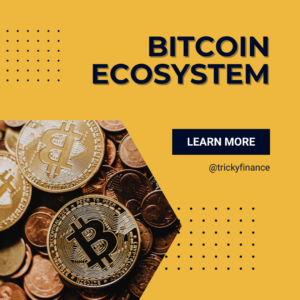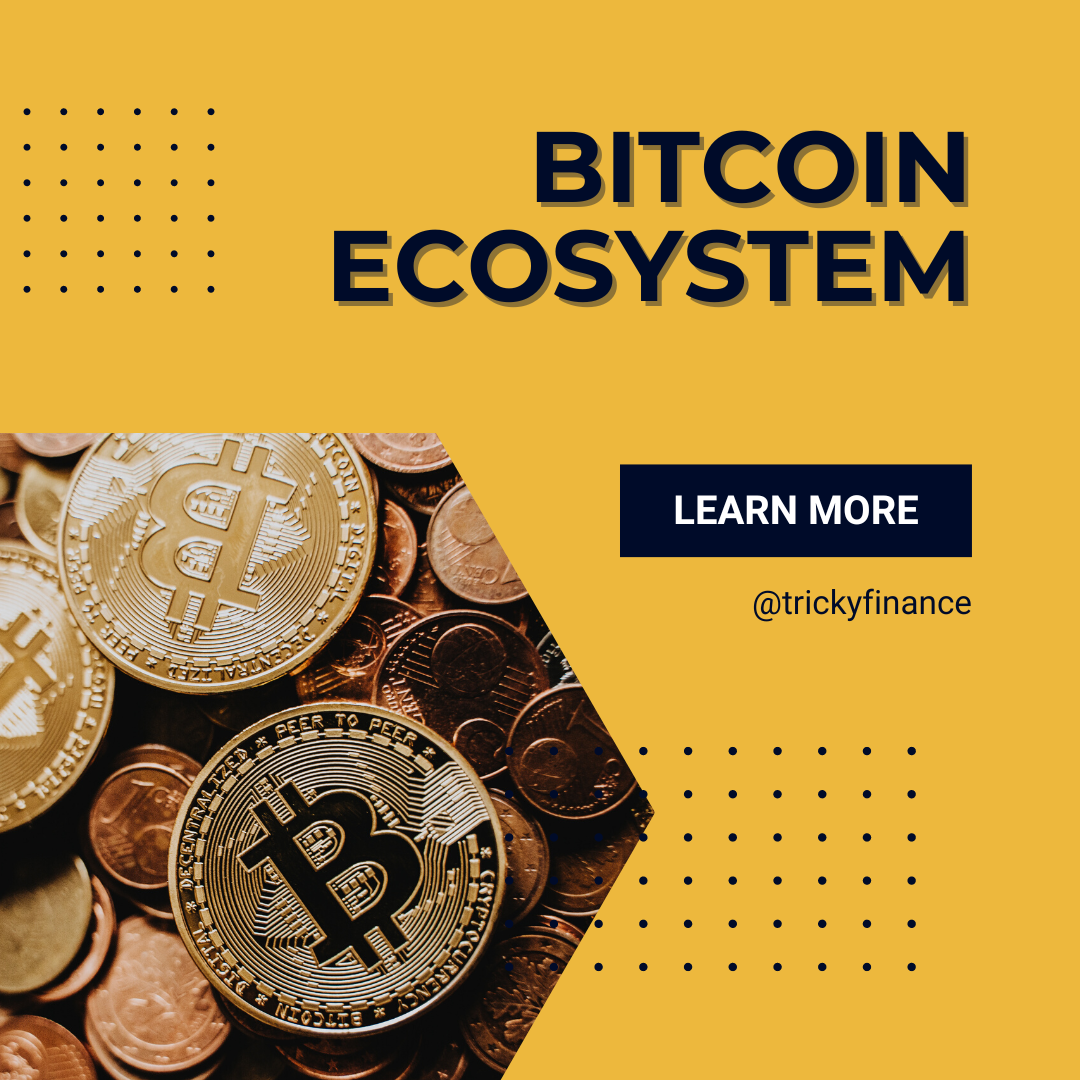The extensive network associated with Bitcoin encompasses a wide array of solutions, protocols, applications, and assets aimed at optimizing the utilization and effectiveness of the Bitcoin Blockchain Network. This inclusive environment spans various decentralized applications (DApps), comprising infrastructures, wallets, trading platforms, non-fungible tokens (NFTs), and Layer 2 solutions. The focal point of this ecosystem revolves around the promotion and advancement of Bitcoin adoption.
In this article we will understand about the Bitcoin ecosystem in brief and about the various projects being built on it.

What is bitcoin?
Bitcoin, a cryptocurrency unveiled to the public in 2009 by an unidentified developer or group known as Satoshi Nakamoto, operates as a virtual currency intended to function as a decentralized means of exchange beyond the influence of any singular individual, entity, or group. This characteristic eliminates the necessity for third-party involvement in financial transactions. Blockchain miners receive Bitcoin as a reward for validating transactions, and the cryptocurrency is accessible for purchase on various exchanges. With the largest market capitalization globally, Bitcoin has undergone a history marked by volatility as a store of value, experiencing multiple boom and bust cycles.
Top Projects building on Bitcoin to watch out in 2024
-
Mintlayer: Empowering Bitcoin with Token Interoperability and DeFi Innovations
Mintlayer is a blockchain technology enhancing Bitcoin’s capabilities by enabling direct token interoperability and fostering trustless finance. As a layer-two protocol on the Bitcoin blockchain, Mintlayer introduces DeFi, smart contracts, tokenization, and decentralized exchange functionalities. It supports multi-token usability, cross-blockchain transfers, token transaction grouping, and peg-in/out. Priced at $0.562895 USD, Mintlayer is actively working on Bitcoin DeFi, offering a smart contract platform using its Script language and the UTXO model. The network employs Dynamic Slot Allotment (DSA) consensus, a hybrid Proof of Stake (PoS) model, securing blocks alongside Bitcoin. Mintlayer is currently live on testnet.
2. Spiderchains: Transforming Bitcoin’s Layer 2 Landscape with Ethereum Compatibility
Spiderchains, an innovative Bitcoin sidechain concept by Botanix Labs, emerges as a potential breakthrough for Bitcoin’s Layer 2 capabilities. Unlike other proposals, such as Drivechains or rollups, Spiderchains uniquely bridge Bitcoin and Ethereum by introducing a second layer with full Ethereum Virtual Machine (EVM) equivalence. Orchestrators manage multisig wallets, depositing BTC collateral to enable Spiderchains’ operation, running both Bitcoin and Spiderchain nodes. With a second-layer Proof of Stake (PoS) system, Spiderchains utilize multisig wallets and escrow bonds to spread risk, preventing total fund compromise. The crypto community closely monitors Spiderchains, as its success could position Bitcoin to compete directly with Ethereum’s smart contract ecosystem.
3. Ark: Layer 2 Scalability and Liquidity Innovation
Ark, a layer 2 protocol, strives to facilitate swift and scalable transactions on the Bitcoin network, overcoming liquidity constraints without the complexities of Lightning. Unlike Lightning, Ark eliminates the need for channel opening or closing, streamlining user onboarding. The protocol utilizes virtual off-chain UTXOs for seamless user-to-user trades and redemption for on-chain UTXOs. Ark introduces Ark Service Providers (ASPs), akin to Lightning service providers, earning liquidity fees for processing transactions. Currently, Ark’s implementation requires users to be online, necessitating a self-hosted client. Enabling offline transactions would require modifications to Bitcoin core, reflecting the protocol’s ambitions for enhanced Bitcoin transaction efficiency.
4. BitVM: Enabling Turing-Complete Bitcoin Contracts
BitVM is a computing paradigm that allows Turing-complete Bitcoin contracts to be expressed and verified on the Bitcoin network without requiring any changes to the network’s consensus rules. The BitVM system is based on fraud proofs and a challenge-response protocol, and uses bit value commitments and logic gate commitments to represent programs 1. It is designed to allow for universal computations on Bitcoin, and has potential applications in games like Chess, Go, or Poker, verification of validity proofs in Bitcoin contracts, bridging BTC to foreign chains, building a prediction market, or emulating novel opcodes 1. However, it is limited to the two-party setting with a prover and a verifier, and requires significant amounts of off-chain computation and communication for both parties to execute programs.
5. Chainway: Sovereign zk Rollups on Bitcoin for Enhanced Decentralization
Chainway is pioneering a sovereign zk rollup on Bitcoin, embedding zk proofs of state changes directly onto the Bitcoin blockchain. This approach allows any Bitcoin node user to validate Chainway and access the complete rollup state using only Bitcoin, thereby enhancing network decentralization. Unlike traditional rollups, Chainway leverages Bitcoin for data availability, eliminating the need for a separate miner network or token. Although it introduces trust assumptions regarding validators, Chainway maintains compatibility with Ethereum’s tooling, easing the transition for developers. Notably, Chainway features a ‘forced transaction’ mechanism, empowering users against potential censorship by rollup sequencers. While currently in development, Chainway presents an intriguing use case alongside experiments by Kasar Labs and RollKit in utilizing Bitcoin as a data availability layer.
6. Bitcoin Covenants: Enhancing Script Flexibility for Controlled Fund Transfers
Covenants propose a significant alteration to Bitcoin’s consensus rules, enabling scripts to impose restrictions on authorized spenders, dictating how acquired coins can be used and transferred. Essentially, covenants allow programmers to define specific conditions for bitcoin movement, such as limiting spending to whitelisted scripts or implementing time-delayed transfers. Despite being a debated concept for over a decade, covenants face the challenge of requiring new op_codes and a softfork upgrade, with key proposals outlined in BIP 118 and BIP 119. These changes aim to introduce a more nuanced and controlled approach to Bitcoin Script programs, reflecting the ongoing evolution of the Bitcoin core protocol.
7. Fedimint: Enhancing Bitcoin Privacy through Federated Chaumian Mints
Fedimint emerges as a modular open-source protocol designed for community-based Bitcoin custody and transactions, prioritizing privacy. Functioning as a federated chaumian mint, it empowers groups to establish Bitcoin-native federated chaumian mints, reminiscent of early privacy-centric e-cash schemes. Notably, Fedimint seamlessly integrates with the Bitcoin Lightning Network, facilitating universal and timely payments. While still in active development, the project’s primary goal is to scale Bitcoin while enhancing privacy. The Fedimint protocol is crafted to prioritize default privacy for balances and payments, offering optimal federated applications and second-party custody solutions tailored for friends, family, and communities.
Princy Agarwal, a postgraduate in English from Delhi University, writes content for Tricky Finance, where they simplify complex financial topics for readers. With a knack for clear communication, Princy’s work helps make finance understandable and accessible to all.




